Different printing patterns endow T-shirts with distinct styles and add value to them. Today’s post introduces the top 6 printing techniques and the 21 most common types of prints on T-shirts.
Screen printing
Silkscreen printing is a traditional and most common T-shirt printing technique. Similar to sunlight filtering through gaps between leaves, the unobstructed ink permeates through the delicate mesh of the screen, forming a pattern on the T-shirt’s surface. The fineness of the mesh in the screen plate affects the final outcome, with higher mesh counts resulting in higher-quality prints.
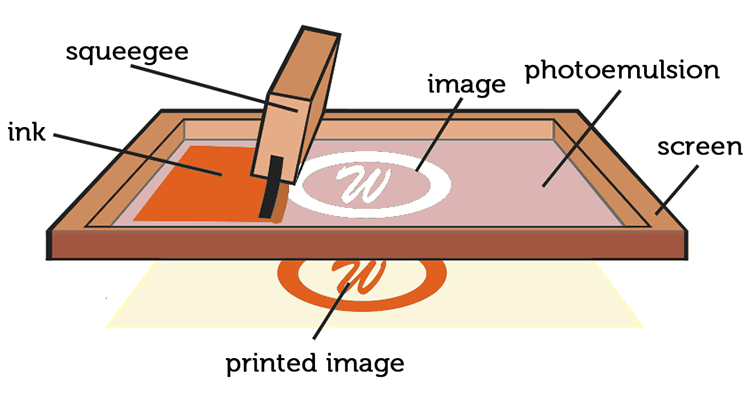
Each color requires a separate screen plate. In practice, screen printing is the easiest and cheapest method to print simple designs with fewer colors on large-quantity T-shirts like 500 pieces or more.
For example, our company has customized 200 pieces of quality T-shirts made of 80% cotton and 20% polyester, weighing 150gsm, with screen prints of the JingSourcing logo as corporate cultural T-shirts. Although our quantity is far less than the MOQ of T-shirt manufacturers, we found some factories to do that based on our long-term cooperative relationship. The custom cultural T-shirt fee is around $2/pc.
Note the fabric types and density (gsm) also affect custom T-shirt prices. This is why I detailed our corporate cultural T-shirt fabric contents and density. Generally, the higher the cotton content and fabric density, the more expensive the custom price; whereas the higher the polyester content and lower the fabric density, the cheaper the customization.
Be sure to contact us to get the exact printing fees for your custom T-shirt prints.
Different inks will produce different printing effects, meeting the diverse customization needs. Here are common 11 types.
Water-based printing
It is the cheapest screen print and is environmentally friendly. Because it uses water-based printing ink, with water as the main component. It is easily absorbed by the fabric, similar to dyeing. Therefore, water-based printing has a soft touch, good breathability, and is wash-resistant, suitable for printing various large patterns on summer T-shirts. However, water-based printing ink has poor coverage and is only suitable for printing on white or light-colored T-shirts.
Plastisol printing
Plastisol printing uses a type of plastic ink, usually PVC or vinyl resin, which is not environmentally friendly. The printed pattern is attached to the T-shirt surface, unlike water-based printing that penetrates fabrics. Therefore, there is an obvious glue-like feeling and poor breathability. Besides, plastisol printing involves more complex processes and higher costs than water-based printing. Therefore, it is not suitable for large-scale printing on T-shirts.
Advantages include working well on both dark and light-colored T-shirts; colors are more vibrant and vivid, with color reproduction far superior to water-based printing. It is important to choose high-quality printing inks to avoid issues such as cracking or peeling.
Screen printing with cracked effects
Such cracked effects is popular among retro-style fashionable T-shirts. This technique involves adding a certain shrinkage reactive material to plastisol printing ink, which shrinks when heated and hardens and cracks when dried, imitating a natural mottled effect, as shown in the picture below. Combining with washing for a retro and vintage T-shirt effect works even better.
Raised rubber printing
Raised rubber printing is actually the repeated process of plastisol printing. A special formula of plastisol ink is used to maintain a three-dimensional shape even after multiple prints. Usually, 5-8 prints can achieve a relatively ideal 3D effect. Typically, large factories can do well, due to high demands on both the workers and the inks.
This printing is often used to emphasize specific parts of the design. The pattern lines should be greater than 3mm, otherwise, after intense washing methods such as washing and spinning drying, the pattern may distort.
Puff printing
Puff printing ink contains a foaming agent, which expands and protrudes after being heated at high temperatures, thereby creating a raised or embossed effect. This is similar to steaming buns after flour fermentation.
It is common to see puff-printed texts and patterns on trendy T-shirts. They are soft, durable, wash-resistant, and elastic. The stimulated effect of fur appeals to environmentally conscious individuals who like fur-like textures. Puff printing is most suitable for T-shirts made of cotton or nylon fabric. This technique is an excellent choice for enhancing the texture of small-area monochrome patterns.
Pearlescent printing
Pearlescent printing involves silk-screening patterns onto T-shirts made of various fabrics using pearlescent ink, resulting in a pearl-like effect. It resembles the texture of shimmering eyeshadow, providing excellent hand feel and durability, as well as resistance to acids, alkalis, and high temperatures. During the printing process, it is preferable to use a 60-80 mesh screen.
Reflective printing
Add reflective powder to water-based printing inks, followed by screen-printing onto T-shirt fabrics. In areas with insufficient sunlight or at night, the printing reflects external light sources, making it safe and cool. This type of printing is popular among fashion-forward individuals and those who engage in nighttime activities such as running or cycling.
Similar to water-based printing, reflective printing has a soft feel and excellent color fastness, and it does not fade even after regular washing.
Glow-in-the-dark printing
Like reflective printing, glow-in-the-dark printing emits light at night. However, the principle differs: it absorbs light energy during the day, storing it, and then emits light spontaneously in dark places at night.
Silicone ink screen printing
It refers to patterns printed using special silicone through screen printing, providing a strong 3D effect and a soft hand feel. The patterns are durable and hard to peel off. Moreover, they appear bright without dimness or lack of luster, hard to fade or color loss after washing.
Besides screen printing, transfer printing plus digital printing can perfom silicone 3D effects.
Discharge print and Imitation discharge print
Discharge print is commonly seen on dark-colored T-shirts, imparting a vintage feel. It is a type of screen printing that uses discharge ink containing a reducing agent and an oxidizing agent to reduce the already dyed fabric to its natural or lighter color, forming patterns.
It has a soft hand feel, seamlessly blending with the fabric’s softness. However, it may have an odor that requires washing to remove.
Imitation discharge print is easy to understand. It uses imitation discharge inks to mimic the printing effect of discharge printing. And it is suitable for large-area printing without the need for washing.
Thermal transfer
Thermal transfer printing can be considered as a supplement to screen printing. Since many overly complex images cannot be completely printed through screen printing, heat transfer printing comes into play.
Simply put, it involves pressing special paper with printed designs onto T-shirts using a heat transfer machine, similar to the temporary tattoos we used to play with. The patterns are realistic in color and are suitable for designs with rich colors and gradients.
Typically, we can divide thermal transfer into the following 2 types.
Sublimation
Sublimation involves evaporating dye ink directly onto sublimation paper at temperatures of 350-400°C, penetrating the fabric to form the pattern. This pattern has a good hand feel, breathability, and durability, without fading over time. However, it only produces good results on white or light-colored T-shirts and requires a polyester content of more than 80%. A good option for quick-drying T-shirts.
Here is a video showing how sublimation printing works.
Heat transfer
Heat transfer, also known as heat press printing, involves transferring the pattern from transfer paper to the T-shirt surface at temperatures of 140-180°C, resulting in a slightly glossy texture without breathability. The color fastness is poor, and frequent washing and drying can cause severe wrinkling and cracking.
It works well on both light and dark-colored T-shirts. Additionally, there are diverse transfer papers with different effects, such as gold and silver heat transfer paper, rainbow heat transfer paper, holographic film, reflective film, laser effect transfer paper, etc. Many POD T-shirt businesses buy pre-made transfer papers, use the machine to cut and engrave texts or patterns, and remove the excess transfer paper, followed by a heat press to obtain the custom prints.
Both sublimation and heat transfer are suitable for small orders. One or two can also be done, so it is well suited to the market for print-on-demand.
For large-area patterns like all-over-print T-shirts, sublimation is better than heat transfer.
Heat transfer patterns are less breathable compared to sublimation.
Under the same order quantity and a similar amount of fabrics, sublimation is cheaper. Sublimation costs are calculated based on the area of the fabric used (in square meters), while heat transfer is charged by the pattern size and the order quantity.
For example, one of our clients printed a design of 5x5cm² on 200 T-shirts, with a cost of $0.6 per piece. The larger the printing size, the higher the cost.
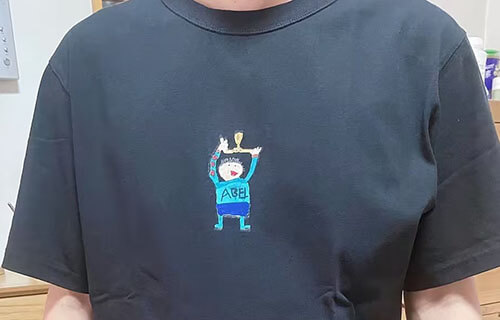
DTG printing
DTG printing, similar to printing photos with a printer, allows direct printing of patterns onto T-shirts. For example, if you have a digital photo of an oil painting, DTG can replicate the rich colors and intricate details of the pattern entirely.
This technique is suitable for printing patterns with rich colors or gradients, and it does not require plate-making. It can be done for even a single piece, suitable for the POD T-shirt businesses.
Here is a video showing how we use DTG to print cool, complex designs on T-shirts.
Unlike heat transfer, DTG ink particles are extremely fine, reaching a nano-level, so they can easily penetrate the fiber gaps of the fabric. This ensures durability while not affecting the softness and comfort of the fabric itself. The printed pattern is breathable, has a good hand feel, and lacks a glue-like sensation.
It is suitable for various T-shirt fabrics. However, it is higher in price. For the same pattern, DTG printing costs twice as much as water-based printing.
Embroidery
Embroidery is the process of sewing threads or other fibers onto fabric to create patterns or designs in certain colors. It can be done by hand or by machine. In the garment industry, machine embroidery is commonly used for mass production.
Here is a video showing how machine embroidery works.
An embroidered pattern is very durable and has a good texture. It is more expensive than the screen-printed pattern. The cost of embroidery depends on the complexity and size of the design, the number of threads used, and the quantity of the order.
Here are common 5 types of embroidery.
Flat embroidery
Flat embroidery is the most widely used and common type of embroidery, where the colors and shapes of the design are showcased. It is suitable for various types of fabrics and is commonly seen on cultural shirts and everyday T-shirts.
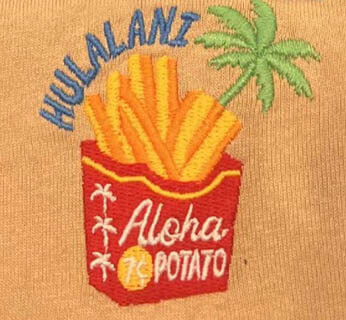
3D embroidery
3D embroidery, also known as dimensional or raised embroidery, has become increasingly popular among fashion T-shirt brands in recent years. For example, embroidered letters or motifs on T-shirts to add depth and texture to the design.
The 3D pattern is created by encapsulating EVA foam within the embroidery threads. It can be produced on a regular flat embroidery machine.

Towel embroidery
Towel embroidery is a highly popular embroidery technique in European and American fashion. The effect resembles having a piece of towel fabric attached, offering a soft touch and a variety of color changes.
During embroidery, special towel machine heads are used to pull ordinary embroidery threads from under the machine, creating loops one after another to achieve the towel effect. It is not suitable for T-shirts made of high-stretch fabrics, as they are prone to deformation and are relatively expensive.

Affixed cloth embroidery
Affixed cloth embroidery is a very convenient and practical auxiliary decoration method. Embroidery factories typically use regular flat embroidery machines to make patches, which are then sold to clothing suppliers who sew the patches onto the garments. Usually, embroidery factories set a custom MOQ of 200.
With the rise of the Dirty Fit style, elements such as distressing, frayed edges, rolled edges, and vintage effects are incorporated into the design of patches.
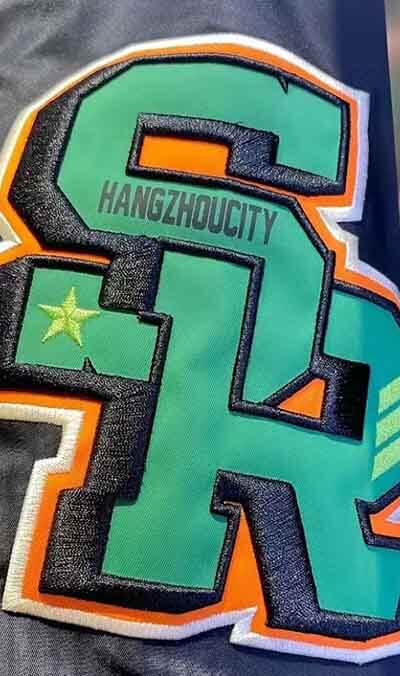
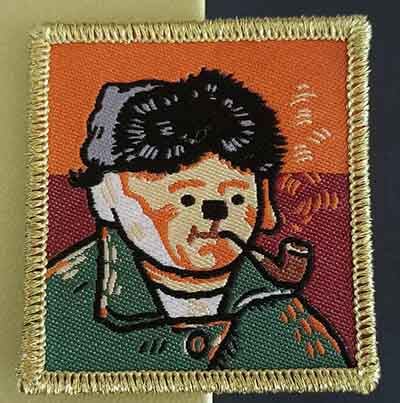
Bead embroidery
Bead embroidery involves linking beads into a string-like material, which is then embroidered using a flat embroidery machine equipped with bead embroidery devices.
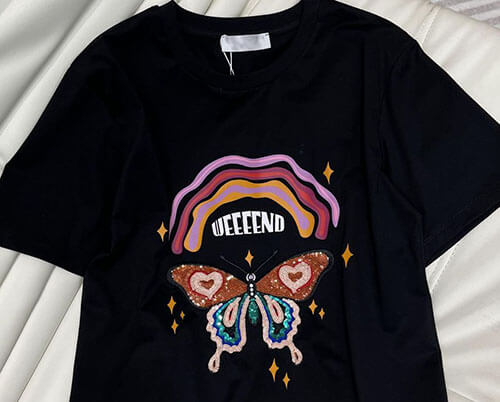
Flock printing
Flock printing, seen on some T-shirts, provides a tactile, plushy sensation with a three-dimensional effect. Typically, a high-strength resin adhesive is screen-printed onto the surface of the T-shirt, followed by using an electrostatic field of a certain voltage to rapidly “bump” flock fibers vertically and evenly onto the adhesive, forming the pattern. This is the traditional method of screen printing flock printing.
Compared to screen printing, heat transfer flock printing is faster. Quality flock fibers are heat-pressed onto the T-shirt using heat transfer paper through a machine.
Another method is flock embroidery. After installing flock needles on a regular flat embroidery machine, the hooks on the flock needles hook the fibers on the flock cloth and sew them onto another fabric.
Either way, the flock print type is suitable for those who prefer a velvety texture, ideal for designs featuring letters or symbols to highlight a specific element. However, it is prone to falling off with frequent washing.
3D Embossed Printing
3D embossed printing involves first brushing a shaping silicone onto the fabric, followed by using a pre-designed embossing mold to directly apply high-temperature heat and pressure onto the fabric to create text and patterns. This process requires mold development based on specific designs, incurring a setup fee, with pricing determined by the quantity ordered.
Puff printing is an alternative option. It offers a similar visual and tactile effect but with better cost-effectiveness, as it does not require mold fees for printing.
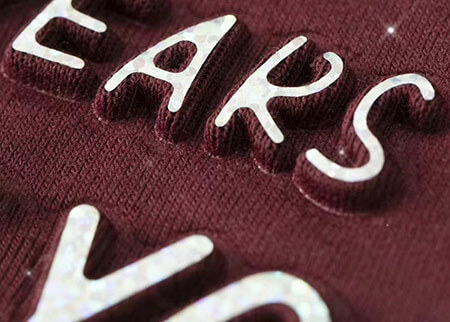
JingSourcing offers diverse, flexible T-shirt printing services
In addition to the popular T-shirt printing types mentioned above, there are many other printing types available that can be combined to achieve unique printing effects. Feel free to tell us about your custom T-shirt printing ideas.
As a leading sourcing company in China, we are located opposite the Yiwu International Trade City, where many high-quality T-shirt suppliers exist. So far, we have helped many clients procure a variety of custom T-shirts with diverse patterns at affordable prices.
Many are e-commerce sellers who customize t-shirt logos and patterns for resale. Some businesses turn to us for custom T-shirts as staff uniforms, team-building activity attire, and more, to meet their corporate culture and brand promotion needs. Additionally, some medium to large POD companies have purchased our blank T-shirts to print creative patterns.
No matter how complex your design is, we can provide you with the best printing solutions based on 10+ years of printing experience, flexibly realizing your desired custom T-shirt effects.
JingSorucing T-shirt custom printing example
We had a client engaging in the POD t-shirt business. She collaborated with platform designers to create a creative oil painting pattern design and wanted to embroider it on t-shirts for 3D quality effects. Before finding us, she contacted many suppliers on Alibaba but was told that embroidery couldn’t replicate the complex colors and details of the pattern. Indeed, in the garment printing industry, achieving this through embroidery is challenging.
The oil painting is not from our client, just for reference.
However, leveraging our agent’s rich experience in T-shirt customization, we came up with a “combination solution” – first embroidering the basic pattern shape at an embroidery factory, and then completing the remaining complex colors and details using digital printing at another factory. The client was very satisfied with the result and placed a second order.
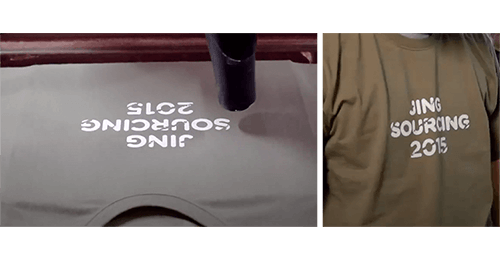
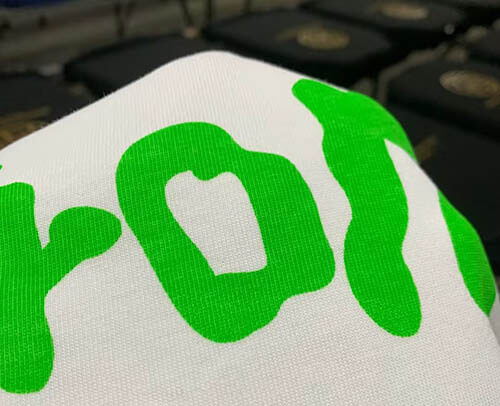
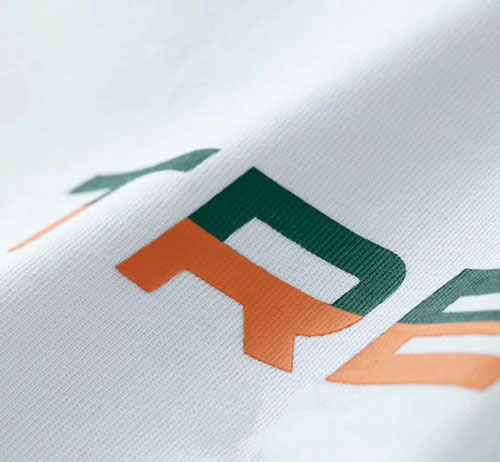
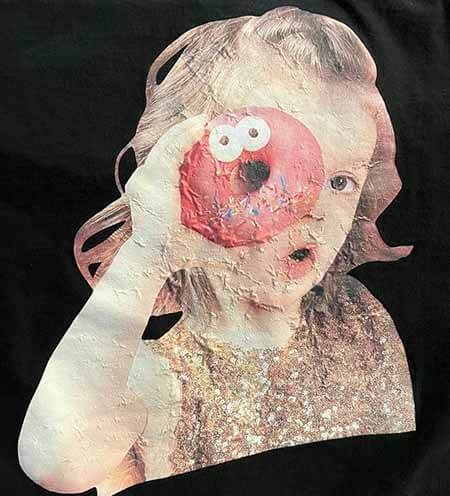
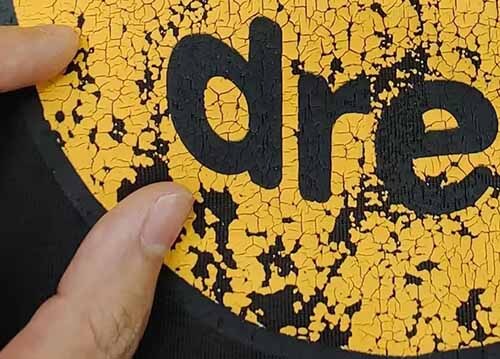
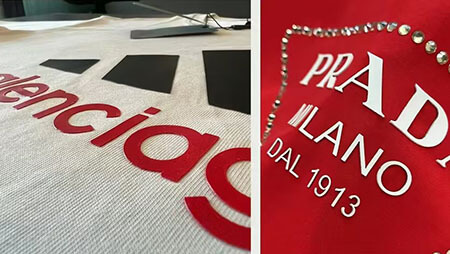

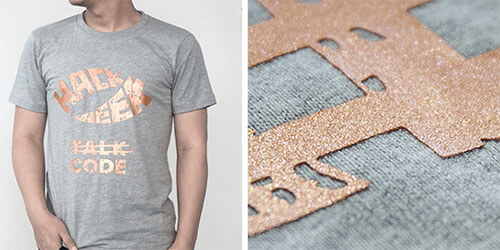
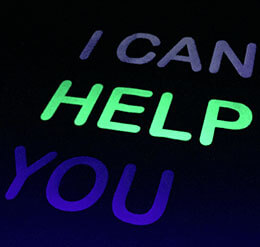

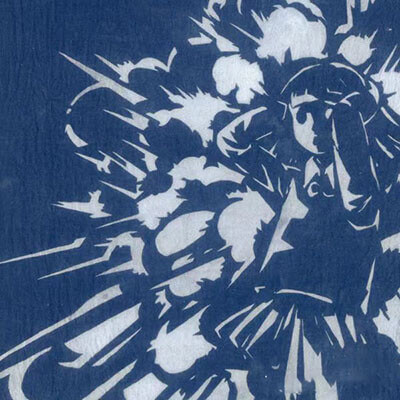
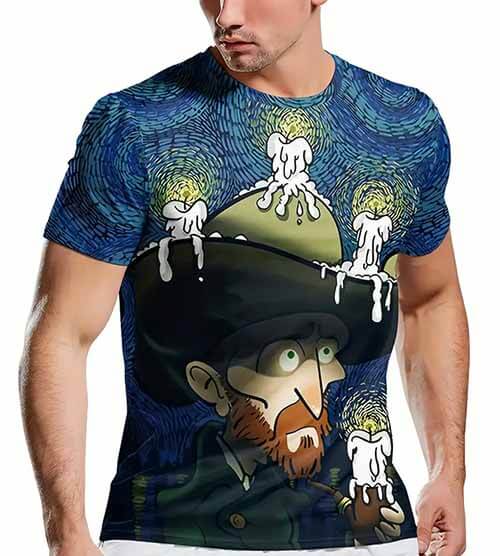
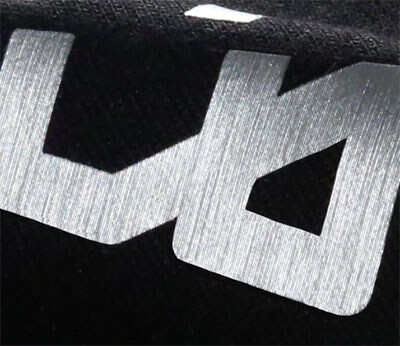
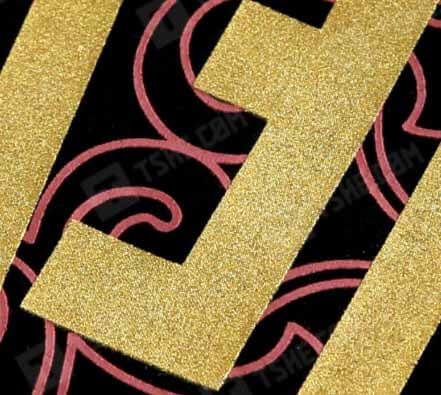

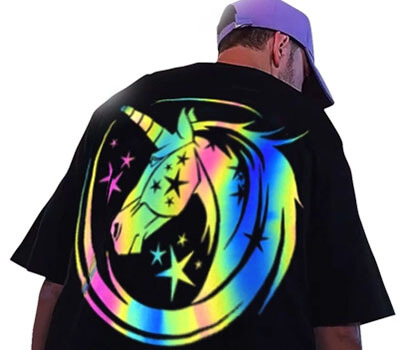
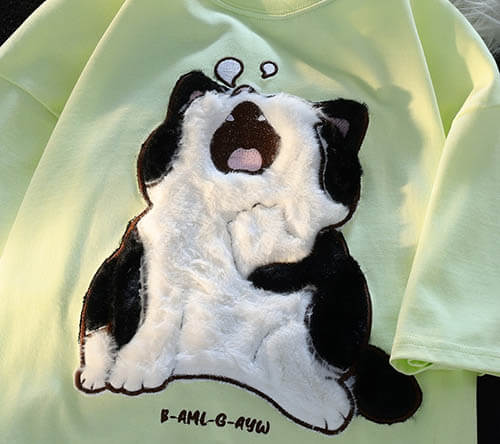
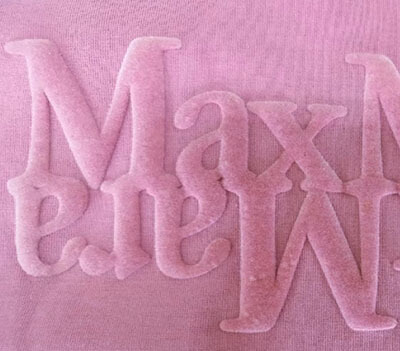
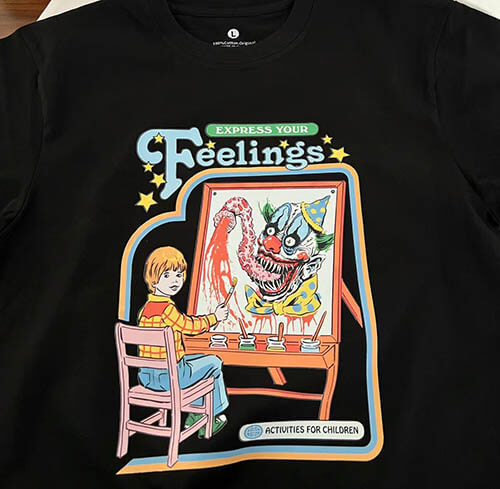

Leave A Comment